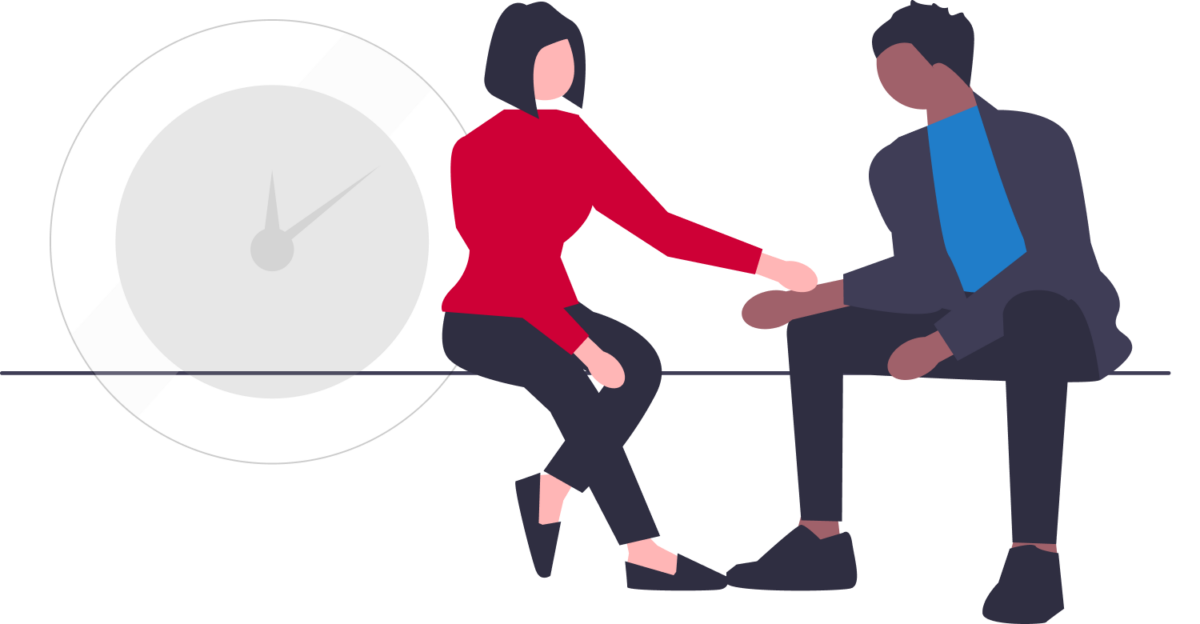Table of Contents
- How & Why to Check a Pulse
- Situations When a Pulse Check Is Necessary
- How to Check a Pulse
- Where to Check the Pulse on an Adult
- Where to Check the Pulse on a Child
- Where to Check the Pulse on an Infant
- Common Mistakes to Avoid When Checking Someone’s Pulse
- Range of Healthy Heart Rates
- What to Do If Someone Has No Pulse
- Pulse FAQs
Checking someone’s pulse is one of the simplest yet most essential medical procedures, providing a look into their heart health.
The pulse is the rhythmic throbbing of arteries as blood flows through them, caused by the beating of the heart. Measuring a person’s pulse can reveal their heart rate and is extremely helpful in emergencies, fitness monitoring, and routine health assessments.
In emergencies, checking a person’s pulse helps determine if their heart is still beating, guiding life-saving actions like CPR.
While many people have a general idea of how to find someone’s pulse, they might not know exactly what to look for or how techniques differ for different age groups, like infants versus adults. For example, an infant pulse check shares similarities with an adult pulse check but requires attention to subtle differences such as the location of the pulse.
In addition to confirming whether a person’s heart is beating, checking a pulse can also identify potential health concerns that need medical attention. When you learn how to find and interpret a pulse, you gain a skill that can be performed on yourself or someone else and can make a difference in life-threatening situations — or even in spotting early signs of health issues.
Read on to explore how to accurately check a person’s pulse and what heart rate differences to keep in mind.
How & Why to Check a Pulse
Regardless of a person’s age, a pulse check helps you determine how fast or slow their heart rate is, measured in beats per minute (BPM). A heart rate that is either too fast or too slow can indicate a problem that requires medical attention, and a person with a heart rate that is dangerously slow or nonexistent may need CPR immediately.
To check a person’s pulse, always use two fingers, but not your thumb. This will help prevent a false reading since the thumb is itself a pulse point. To determine a person’s heart rate, count the number of pulses you feel in 30 seconds, then double that number for the total number of beats per minute.
Understanding Pulse Points
Pulse points are specific areas on the body where arteries run close to the skin’s surface, making it easier to feel the rhythmic beat of the heart. Each pulse point provides valuable information about circulation and heart health, and knowing where these points are can help you check someone’s pulse quickly and effectively when needed.
The most commonly used pulse points include the radial, brachial, and carotid arteries.
The radial artery is located on the wrist just below the thumb, and the carotid artery is found on either side of the neck near the windpipe (or in medical terms, the trachea).
These pulse points are ideal for taking the pulse of adults and older children because they are easy to access and provide a strong, consistent pulse. For infants, the brachial artery on the inside of the upper arm is often used, as it is more reliable and easier to locate than wrist or neck pulses.
Other pulse points include the femoral artery in the groin, the popliteal artery behind the knee, and the dorsalis pedis artery on the top of the foot. These pulse points are often used in medical settings to assess blood flow to specific areas of the body or in cases where a wrist or neck pulse is not detectable.
Understanding these pulse points is not just about location but also about knowing which is most appropriate for different situations. Typically, the radial artery is the most commonly used pulse point for routine checks. In an emergency, the carotid artery is preferred for its strong, clear pulse, while the brachial artery is the go-to for all infants.
When you familiarize yourself with these pulse points and how to locate them, you’ll be better prepared to assess heart rate and circulation accurately in any circumstance.
Situations When a Pulse Check Is Necessary
Knowing how and when to check a pulse can be lifesaving or provide essential health insights. Pulse checks are beneficial in a variety of situations, from responding to emergencies to monitoring overall well-being.
The most common situations when checking someone’s pulse is necessary include:
- During medical emergencies. In situations such as cardiac arrest, drowning, or severe trauma, checking a pulse is the first step in determining whether the heart is beating. A quick assessment can guide actions like CPR or defibrillation. It also helps emergency responders evaluate the severity of the situation.
- Performing routine health assessments. Healthcare professionals check pulses during routine exams to evaluate heart rate and rhythm. An irregular or unusually fast or slow pulse can signal health concerns, such as arrhythmias, dehydration, or underlying cardiovascular conditions.
- Keeping an eye on certain health conditions. For individuals managing chronic conditions like heart disease or hypertension, regular pulse checks can help track symptoms and assess the effectiveness of treatments. It’s also useful for people recovering from surgery or illness to monitor their recovery progress.
- Caring for infants or children. Knowing how to check an infant’s pulse is essential for recognizing abnormal heart rates or responding to emergencies. Infants have higher resting heart rates than adults, and being familiar with what’s normal for their age can make it easier to detect potential issues.
- Monitoring heart rate during exercise. Athletes and fitness enthusiasts often monitor their pulse during workouts to optimize performance, prevent overexertion, and improve cardiovascular health.
Whether it’s for an emergency or routine check-in, knowing when and why to check a pulse equips you with a valuable tool to assess health and respond effectively, no matter the situation.
How to Check a Pulse
Checking someone’s pulse may seem straightforward, but taking a few steps to properly prepare ensures you get an accurate reading. Creating a calm environment, positioning the person correctly, and understanding the right techniques for different situations are essential for successful pulse checks.
Preparing to Take Someone’s Pulse
Before checking a pulse, it’s important to be in a calm and quiet environment. Distractions or loud noises can make it difficult to focus on detecting the subtle rhythm of a heartbeat. If the person is anxious or stressed, encourage them to take a few deep breaths to help relax.
Positioning is also key. The person should be seated or lying down in a comfortable position. If they’re seated, their arm should rest on a stable surface at heart level to ensure an accurate reading. For those lying down, keeping their arms relaxed at their sides is ideal.
Take a moment to warm your hands before beginning, as cold hands can make the process uncomfortable and harder to perform. Finally, make sure you’re familiar with normal pulse ranges for the person’s age group.
Ways to Take Someone’s Pulse
Taking someone’s pulse is about finding the right pulse point and using the correct method based on the situation.
For an accurate reading, start by using your index and middle fingers, never your thumb, as it has its own pulse that can interfere. Gently press your fingers over the chosen area until you feel the rhythmic beat. Be careful not to apply too much pressure, as this could obstruct blood flow or make the pulse harder to detect.
When measuring the pulse, timing and
proper multiplication are key.
Count the beats for 30 seconds and multiply by two to estimate the heart rate per minute. If you suspect an irregular rhythm, count for a full minute to get a precise measurement.
For infants, be mindful of their naturally faster heart rates and use the brachial artery for more reliable access.
Where to Check the Pulse on an Adult
In adults, the two best arteries to use when taking a pulse are the radial and carotid arteries.
Taking the Radial Pulse on an Adult
Taking the radial pulse is the most common method used for conscious adults. Follow these steps to take a person’s radial pulse:
- Step 1: Hold the person’s hand out in a natural position.
- Step 2: Place your index and middle fingers on the underside of the person’s wrist, just below where their thumb connects with their wrist.
- Step 3: At this point, you should notice a subtle but noticeable beat.
- Step 4: Use a stopwatch or clock and count the number of beats in a minute.
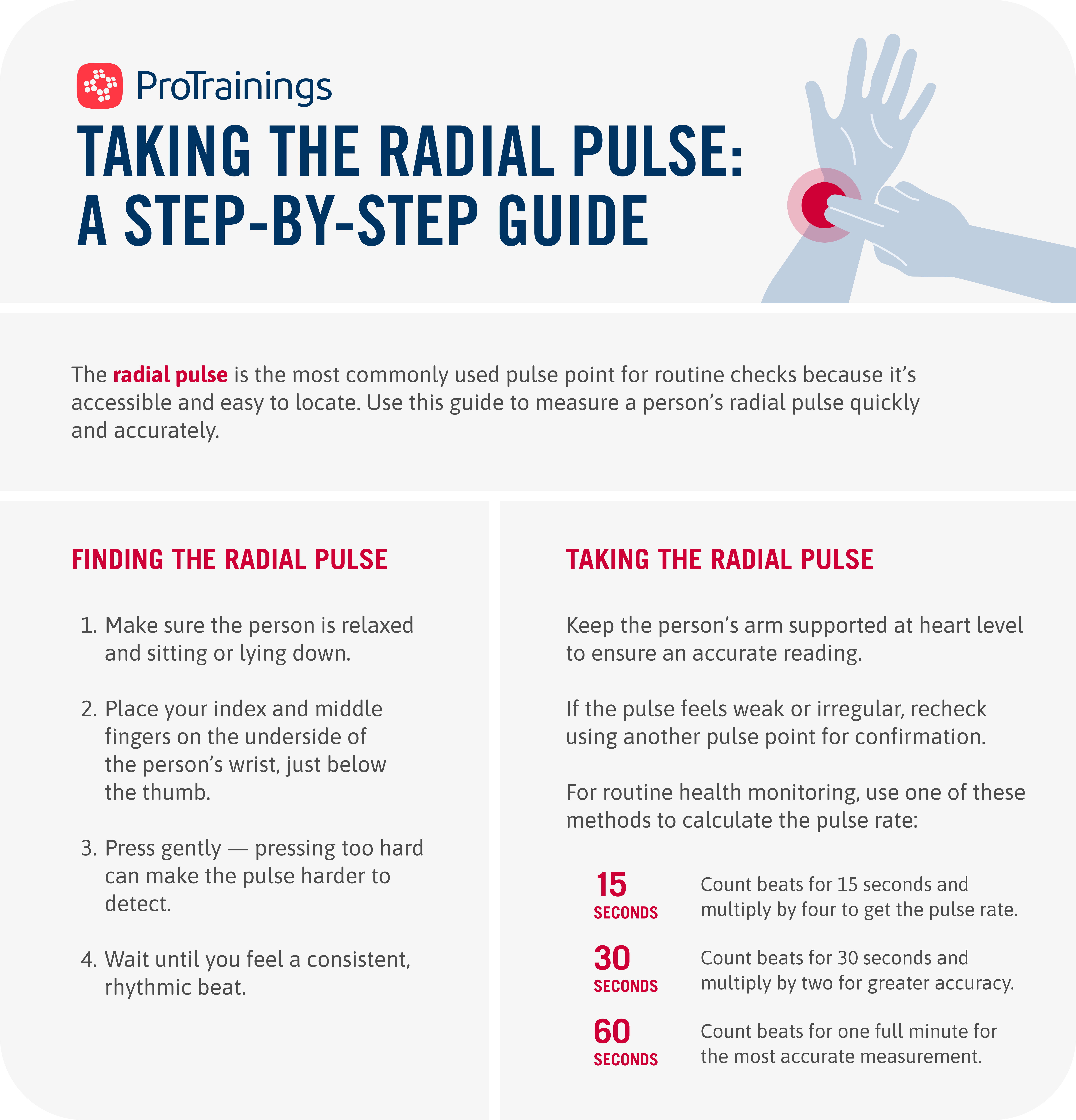
While the radial pulse is the most commonly used for adults, the carotid pulse is also used in certain circumstances.
Taking the Carotid Pulse on an Adult
If a person has a systolic blood pressure lower than 80 mmHg — for instance, in an emergency situation where the person is passed out — you may not be able to feel the radial pulse. Use the following steps to check the carotid pulse:
- Step 1: Place your index and middle fingers on either side of the person’s neck, just below the jawline and next to the windpipe, until you feel a gentle pulse.
- Step 2: Press just hard enough to feel the beat consistently. Pressing too hard can cut off circulation to the brain.
- Step 3: Use a stopwatch or clock and count the number of beats in a minute.
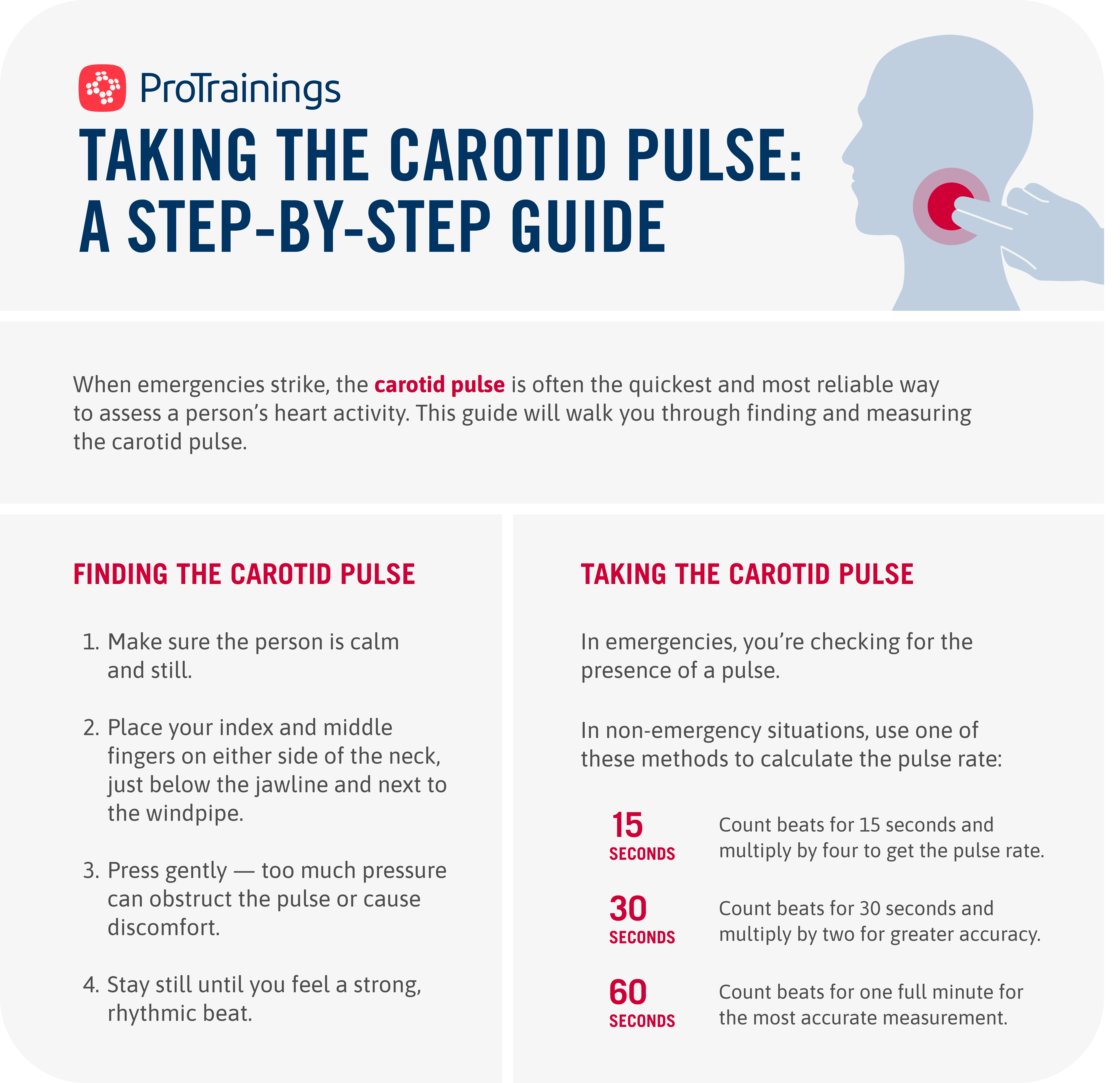
What to Know About Adult Pulse Rates
A normal resting pulse rate for adults ranges from 60 to 100 beats per minute, though highly active individuals may have rates as low as 40 to 60 beats per minute.
Temporary pulse rate increases due to exercise, stress, or excitement are normal, but consistently elevated (tachycardia) or low (bradycardia) rates may signal health issues, especially if accompanied by symptoms like dizziness, fatigue, or chest discomfort.
A healthy pulse should also be steady and regular. Irregular rhythms, such as skipped or erratic beats, could indicate underlying heart conditions like atrial fibrillation.
Where to Check the Pulse on a Child
Checking a child’s pulse requires understanding which pulse points are most reliable based on their age and physiology. Unlike adults, children’s smaller size and naturally higher heart rates can make certain pulse points more difficult to locate or interpret accurately.
The method and location you choose should depend on the child’s age, the situation, and the need for clinical information.
For children over one year old, the radial pulse is often the easiest and most practical option during routine checks. However, in very small children, the radial pulse is often too faint and fast to be useful. In such cases, the brachial, carotid, or femoral pulse may be more effective. The carotid pulse is especially useful during emergencies or when the child is unresponsive.
For situations where a clear indication of blood flow and blood pressure is required, the femoral pulse can provide additional clinical insight. Found in the groin area where the top of the (anterior) thigh meets the hips, this pulse point is located in the femoral triangle.
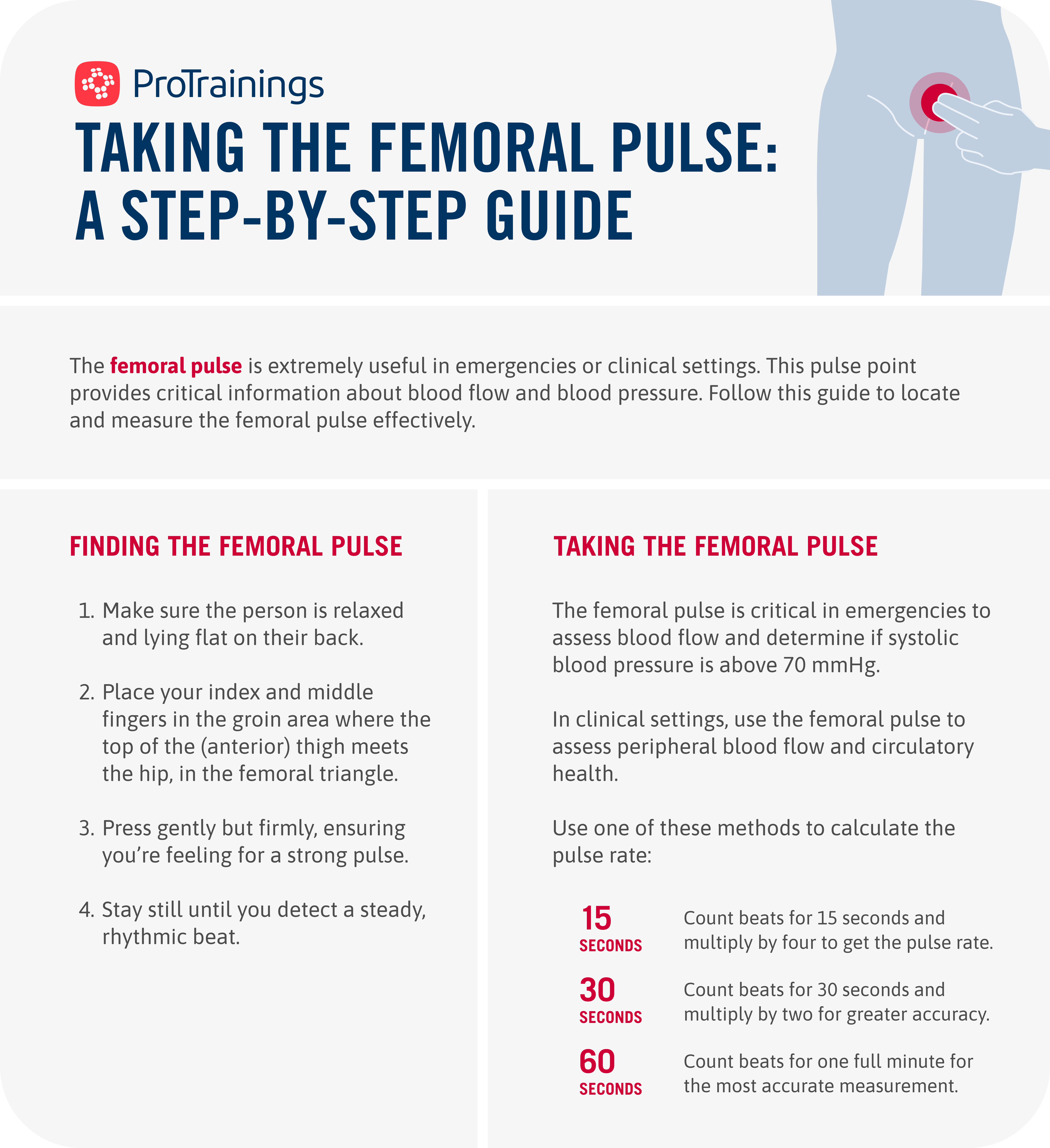
What to Know About Child Pulse Rates
Children’s pulse rates vary by age and activity level, with younger children typically having faster resting rates than older ones. For children one year and older, a normal awake and resting pulse rate ranges from 80 to 140 beats per minute in toddlers and preschoolers and 60 to 118 beats per minute in school-aged children and teens.
Activity, emotions, or illness can temporarily elevate a child’s pulse rate, which is usually normal. However, consistently high resting rates may indicate issues like fever or dehydration. Similarly, an unusually slow pulse rate, particularly if paired with symptoms like dizziness or fatigue, should be checked by a healthcare provider.
A child’s pulse should also have a steady, regular rhythm. Irregularities, even when the pulse rate is normal, can point to other health concerns. Recognizing what’s typical for a child’s age helps determine whether their pulse rate is within a healthy range or requires further attention.
Where to Check the Pulse on an Infant
For infants, the brachial artery is the most effective vessel to use to check heart rate, as their wrists are often too fatty to get a radial or carotid pulse and their necks aren’t fully developed.
You can find the brachial pulse by bending the infant’s arm so their hand touches their ear and feeling the inner arm between the shoulder and the elbow. Place two fingers between the bicep and tricep and gently push up into the humerus bone to find this artery to check for a pulse.
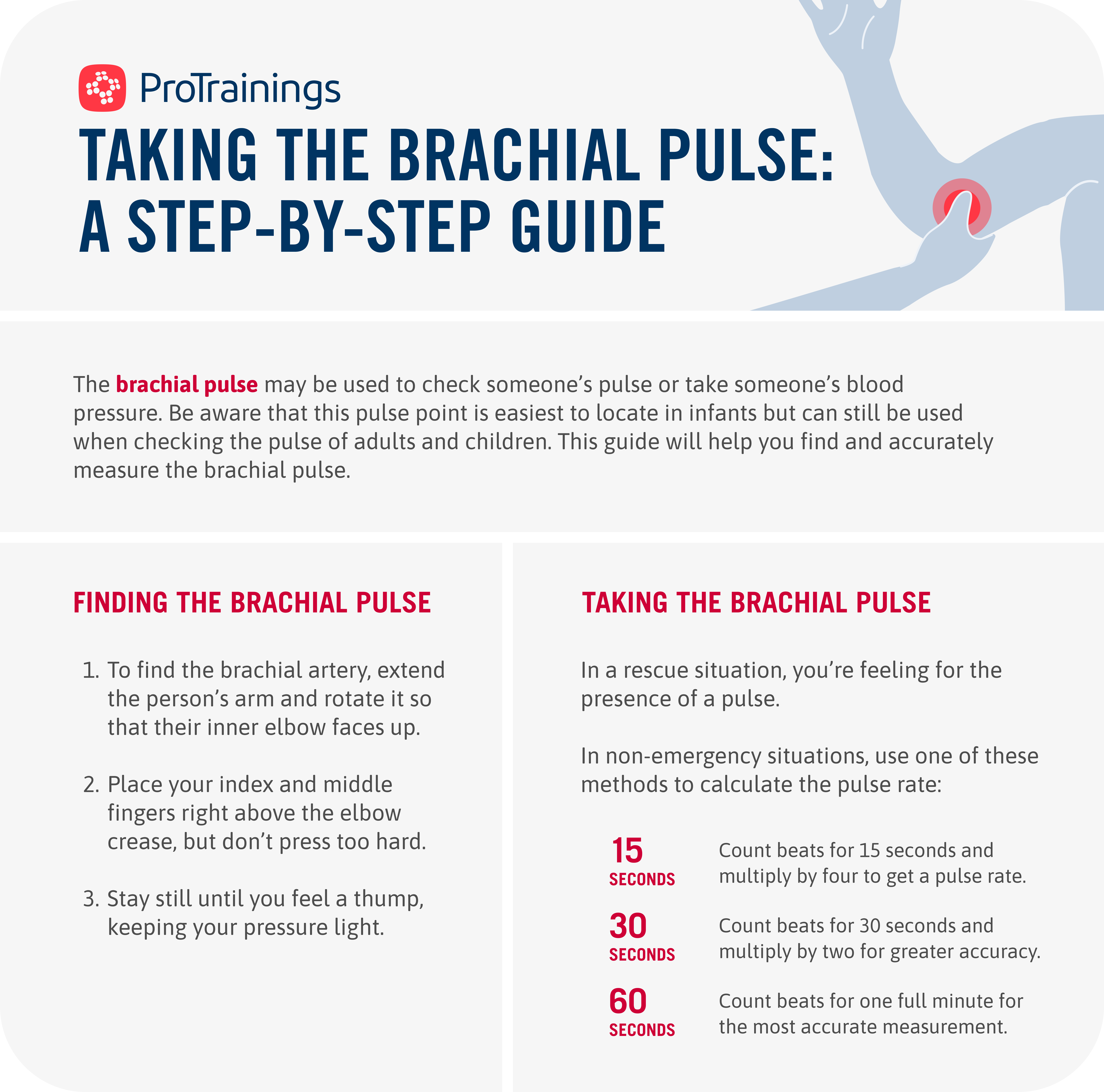
What to Know About Infant Pulse Rates
In some emergency situations, your main concern while performing an infant pulse check will likely be whether the infant has a pulse at all. However, it’s also important to know what a normal pulse rate for an infant feels like, so you can get help if the infant’s pulse is either too fast or too slow.
In general, infants have a faster pulse rate than adults. While a normal resting pulse rate for an adult is usually 60 to 100 beats per minute, an infant’s resting pulse rate is typically 100 to 160 beats per minute.
Some variation from these average rates does not necessarily mean there is a life-threatening problem. However, it’s always best to consult a medical professional if you notice that your infant’s pulse rate is much faster or slower than usual, especially if they have other symptoms of respiratory issues or if the pulse seems irregular in any way.
Pro Tip: Checking an Infant’s Pulse with a Stethoscope
If you are a medical professional or have experience using a stethoscope, try this technique, which is often easier than taking an infant’s pulse using the brachial pulse method.
- Step 1: Place the diaphragm of the stethoscope directly over the heart on the left side of the infant’s chest.
- Step 2: Count each heartbeat for 30 seconds and multiply by two to estimate the heart rate per minute.
According to ProTrainings’ own EMT, Jason Courtade, this is often an easier approach given that it is difficult to keep a consistent pressure and location on an infant’s arm, especially if the infant is moving around.
Using a stethoscope allows you to focus less on the pressure and placement and more on accurately counting heartbeats.
Common Mistakes to Avoid When Checking Someone’s Pulse
Checking someone’s pulse might seem simple, but small errors can lead to inaccurate readings or missed health insights. Avoiding these common mistakes gets reliable results so you can act appropriately based on your findings.
One of the most frequent mistakes is using your thumb to check a pulse. Since the thumb has its own detectable pulse, it can interfere with accurately identifying the other person’s heartbeat. Always use your index and middle fingers instead.
Another common error is pressing too hard on the pulse point, which can obstruct blood flow and make it harder to detect a beat. Find the balance of gentle pressure.
Additionally, failing to account for external factors, such as the person’s recent physical activity or emotional state, can lead to misinterpretation. Always allow a few minutes for the person to calm down before taking their pulse.
Math mistakes are some of the most common issues that lead to miscalculations of pulse rates. Make sure you are multiplying correctly based on how many seconds you count for or be sure to count for a full minute so math is not needed.
| Pulse Count Duration | Multiply By |
| If you count the pulse for 10 seconds… | …multiply by 6. |
| If you count the pulse for 15 seconds… | …multiply by 4. |
| If you count the pulse for 20 seconds… | …multiply by 3. |
| If you count the pulse for 30 seconds… | …multiply by 2. |
Lastly, overlooking irregular rhythms is another mistake to avoid. While counting beats per minute is important, you should also pay attention to whether the pulse is steady or irregular. Irregular rhythms can signal heart issues that warrant medical attention, even if the rate falls within the normal range.
Being mindful of these common pitfalls will help you improve the accuracy and reliability of pulse checks, guaranteeing your assessment is both effective and meaningful.
Range of Healthy Heart Rates
The normal resting heart rate (meaning your heart rate while sitting or lying down) for a normal adult is 60 to 100 beats per minute. Having a heart rate over 100 BPM is known as tachycardia, and having one lower than 60 is known as bradycardia.
Tachycardia can indicate cardiovascular disease or extreme stress. If untreated, it can lead to strokes, blood clots, and even heart attacks. Ideally, most adults should shoot for a resting heart rate below 75.
Bradycardia sometimes occurs in athletes with extremely efficient hearts, in which case a low heart rate would be normal for them. However, for some people, ultra-low heart rates can indicate heart defects, thyroid issues, and other health problems.
Children under 12 tend to have
faster heart rates than adults.
Children under 12 tend to have faster heart rates than adults. Once they are over 12 years old, they should be in the range of a typical adult. Here are children’s resting heart rate ranges based on age:
- Newborn: 100 to 205 BMP
- 30 days–1 year old: 100 to 180 BMP
- 1–3 years old: 98 to 140 BMP
- 3–5 years old: 80 to 120 BMP
- 6–12 years old: 75 to 118 BMP
If a child’s resting heart rate falls above or below the normal range for their age without reason, contact a medical professional.
What to Do If Someone Has No Pulse
In an emergency, first responders and medical personnel may encounter an unresponsive person with no pulse.
If the person has no pulse, their heart has stopped beating, which could be due to cardiac arrest. This means that the victim is clinically dead; however, it doesn’t mean they are biologically dead. In fact, they could be revived, but they need immediate cardiopulmonary resuscitation (CPR) to survive.
In situations like this, quick actions save lives, and knowing how to check someone’s pulse can be the first step in making a real difference. Whether you’re helping a friend, family member, or coworker, this simple technique can give you the confidence to act when it matters most.
But why stop there? Getting CPR certified takes your preparedness to the next level, including teaching you how to perform chest compressions and rescue breaths and use an AED. Empower yourself and your team to step up and help when someone’s life depends on it by signing up for our CPR certification courses today.
Pulse FAQs
It’s natural to have questions about pulse checks. From what a pulse feels like to how technology can assist, the FAQ below covers common concerns and provides clear answers so you can confidently perform pulse checks.
- What does it feel like when you check a pulse?
A pulse feels like a steady, rhythmic tapping or throbbing under your fingertips. The sensation varies depending on the pulse point, the person’s circulation, and how firmly you press. Larger arteries, like the carotid, often feel stronger than smaller arteries, like the radial. - What if I notice missed beats while taking someone’s pulse?
Missed beats or irregular rhythms may indicate an arrhythmia or other heart issue. If the person is healthy and symptom-free, occasional irregularities might not be serious. However, frequent irregular beats or accompanying symptoms like dizziness or chest pain should be evaluated by a healthcare provider. - Can I check a pulse using my thumb?
No, it’s not recommended to use your thumb to check someone’s pulse. The thumb has its own detectable pulse, which can interfere with accurately feeling the other person’s heartbeat. Use your index and middle fingers instead. - Can I use a smartwatch or fitness tracker to check a pulse?
Yes, many smartwatches and fitness trackers can measure heart rate, making them convenient for quick checks. However, these devices may be less accurate during activity or if not positioned correctly. For precise results, especially in emergencies, manual pulse checks are more reliable. - What if I can’t find the pulse?
If you can’t locate a pulse, ensure you’re pressing gently but firmly on the correct spot. If the person is calm and still but the pulse remains undetectable, seek medical help. If the person is unconscious or showing signs of distress, treat it as an emergency. Call 911 and perform CPR until help arrives. - Are there situations where I shouldn’t check a pulse?
Pulse checks are generally safe and appropriate in most situations. However, if the person is in visible distress or resisting, prioritize calming them or contacting medical professionals for assistance. - How accurate is checking a pulse manually?
Checking someone’s pulse manually takes significant practice to become proficient and accurate. While manual pulse checks are highly accurate when performed correctly, studies show that even healthcare professionals do not always perform these checks accurately. Remember that it takes practice and concentration to increase your accuracy when manually checking a pulse. - Why is it important to know different pulse points?
Each pulse point offers specific advantages based on the situation. For example, the carotid pulse is ideal in emergencies due to its strength, while the radial pulse is commonly used for routine checks. Familiarity with multiple pulse points ensures flexibility in assessing heart rate across various scenarios.
By proactively addressing these common questions, you’re building a foundation of knowledge of health and preparedness that is more than simply checking a pulse. Taking the time to learn and practice prepares you for immediate action and nurtures a deeper awareness of the body’s signals.
